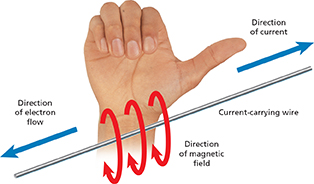Figure 7 If you point the thumb of your right hand in the direction of the current, your fingers curve in the direction of the magnetic field. Inferring How can you determine the magnetic field direction from the direction of electron flow?
 d
dMagnetic Fields Around Moving Charges
Oersted's discovery about the relationship between a current-carrying wire and a magnet established an important physics principle.  Moving electric charges create a magnetic field. These moving charges may be the vibrating charges that produce an electromagnetic wave. They may also be, as in Oersted's experiment, the moving charges in a wire. Figure 7 shows how to remember the direction of the magnetic field that is produced. The magnetic field lines form circles around a straight wire carrying a current.
Moving electric charges create a magnetic field. These moving charges may be the vibrating charges that produce an electromagnetic wave. They may also be, as in Oersted's experiment, the moving charges in a wire. Figure 7 shows how to remember the direction of the magnetic field that is produced. The magnetic field lines form circles around a straight wire carrying a current.
Forces Acting on Moving Charges
Recall that an electric field exerts a force on an electric charge. The force is either in the same direction as the electric field or in the opposite direction, depending on whether it is a positive or negative charge.
The effect of a magnetic field on a moving charge is different, as shown in Figure 8. A charge moving in a magnetic field will be deflected in a direction perpendicular to both the magnetic field and to the velocity of the charge. If a current-carrying wire is in a magnetic field, the wire will be pushed in a direction perpendicular to both the field and the direction of the current. Reversing the direction of the current will still cause the wire to be deflected, but in the opposite direction. If the current is parallel to the magnetic field, the force is zero and there is no deflection.

What are two kinds of moving charges that can create a magnetic field?
Figure 8 A moving positive charge is deflected at a right angle to its motion by a magnetic field. Inferring In what direction would the particle be deflected if it had a negative charge instead of a positive charge?
 d
d



